Nov-03-19
 | | KEG: An exciting fourth round draw between the eventual 2nd prize winner (Schlechter) and Tchigorin (who ended up tied for third). Schlechter and Tchigorin squared off 24 times in their careers, with Schlechter winning 10, losing 6 with 8 draws. In games featuring the King's Gambit--as here--Tchigorin came out ahead 3 wins against 1 loss and three draws. This was no surprise. Tchigorin was a wizard in King's Gambit games. He won the Vienna 1903 King's Gambit tournament (winning both of his games there against Schlechter). Tchigorin also won en exhibition match against World Champion Emmanuel Lasker in which the King's Gambit had to be played in all games. Tchigorin had played the same variation of the King's Gambit in defeating Schlechter in their game at London 1899. Schlechter was thus brave in entering the same variation of the King's Gambit here with which he got crushed by Tchigorin at London 1899. 1. e4 e5
2. f4 exf4
3. Bc4?!

click for larger viewThe wild and crazy "Bishop's Gambit." Tchigorin was expert in this line, playing it 12 times in his career. It was also a favorite of Charousek 7 times); Blackburne (5 times), Janowski (twice), as well as by Schlechter and Lasker. It was later a favorite of David Bronstein (who played it 5 times) and Judit Polgar (who played it 7 times_ and her sister Sofia (who played it 5 times)[Susan Pokgar also played it once). Bobby Fischer shocked Larry Evans at the 1963-1964 US Championships by 3. Bc4?! en route to his 11-0 finish. (Fischer also played the move on two other occasions). 3... Nf6
Maroczy championed this move. Schlechter played it three times against Tchigorin (including in his 1899 London debacle). The wildest alternatives are 3...d5?! and 3...Qh4+?! Best is probably 3...Nc6. Replaying the same variation against Tchigorin suggests that Schlechter had an improvement in mind. If so, we will never find out what any such improvement was since Tchigorin varied from the 1899 game on his 7th move. 4. Nc3
The favorite move here of Tchigorin, Paulsen, Alapin, Charousek, and Rudof Spielmann. It is probably better than 4. d3 immediately. 4... Nc6
Steinitz' move, later adopted by Bogoljubow. 4...c6 is perhaps Black's best here. 5. Nf3
Played multiple times in this position by Tchigorin, Rudof Spielmann, and Alapin. 5. d3, the main alternative, is at least as good. 5... Bb4
The most usual line, and probably best. Tchigorin and Schiffers both played it twice; and Victor Korchnoi tried it many years later. 6. 0-0
6. e5?! would be interesting, but the text is most common and certainly reasonable. 6... 0-0
This move, attributed to Henry Bird, was criticized by Hoffer in analyzing Tchigorin's victory over Schlechter in the book of the London 1899 tournament. The text, however, has survived despite Hoffer's comments and has been played numerous times with no lack of success. The position was now:

click for larger viewIt is here that Tchigorin varied from his 1899 game against Schlechter: 7. d3
Tchigorin had played the powerful 7. e5! at London 1899. He must have feared Schlechter's preparation in choosing the less ambitious (and in my opinion inferior) text. Tchigorin defeated Schlechter with the text at the 1903 King's Gambit tournament, but lost to Swiderski. He later played the text against Alapin at Barmen 1905 (the game was drawn). After 7. d3, the position was:
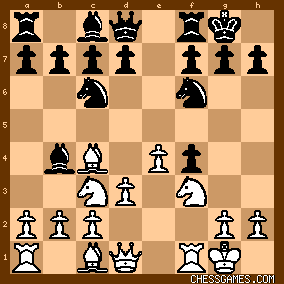
click for larger view |
|
Nov-03-19
 | | KEG: Post II
7... BxN
8. bxB d5!
With this move, Schlechter obtained the better game: 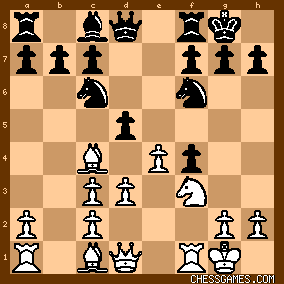
click for larger view9. exd5
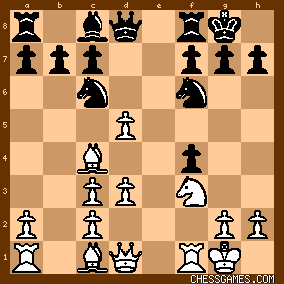
click for larger viewSchlechter reached this same position a year earlier in his game against last-place finisher Sterling at Paris 1900. He played the weak 9...Ne7? against Sterling, but nonetheless won quickly when Sterling overlooked a simple Queen fork and resigned after move 18. 9... Nxd5
This obvious was also played by Schlechter in one of his 1903 games against Tchigorin at the 1903 Vienna King's Gambit tournament. 10. BxN QxB
11. Bxf4

click for larger view11... Ne7?
Anticipating a King-side attack by Tchigorin and hastening to bring his Knight to that wing (on g6). But the Queen-fork by 11...Qc5+ was best, and was played by Schlechter in his 1903 game against Tchigorin and by Alapin in his 1905 drawn game against Tchigorin at Barmen. The move indirectly protects the Black pawn on c7 [12. Bxc7 Qc5+] and does not allow Tchigorin to trade off one of his doubled c-pawns for Black's healthy pawn on c7. All the same, 11...Qc5+ was the only way for Schlechter to maintain his better position. 12. Kh1 Qc5
Having declined to play his Queen to c5 on his prior move, Schlechter might have tried 12...c5. 12...Nf5 was also a reasonable possibility. 13. c4

click for larger viewBoth sides had survived this tricky opening and chances were now about equal. With Tchigorin, however, no position was "safe." Like Alekhine and Kasparov after him, Tchigorin had the ability to breath tactical complexities in even the simplest position. Schlechter was undoubtedly aware that this game was far from over. 13... Ng6
14. Bg3 b6

click for larger view15. Rb1
Most players would place the Queen or Rook on the e-file or perhaps play the reasonable 15. a4. But Tchigorin liked to attack on both sides of the board. 15... a6
15...Bb7 or 15...Bd7 immediately were simpler.
16. Qd2 Bb7
17. Qf2 Qe7
Declining the chance to trade Queens. 17...Qc6 was another reasonable choice. 18. Nd4
Many attacking players would commence a King-side assault with 18. h4. But Tchigorin wanted to bring his Knight fo f5 first. 18... Qd7
19. Nf5
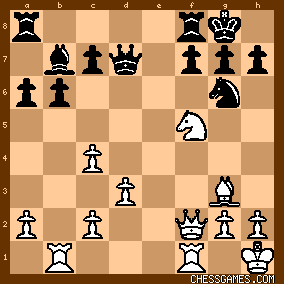
click for larger viewThe preliminaries were now over and the wild struggle was about to begin. As will be seen, in the ensuing tactical melee, both sides erred, and both sides had and missed chances to exploit their opponent's missteps. |
|
Nov-03-19
 | | KEG: Post III
The preliminaries were over and now--as Tchigorin's attack picked up steam--the excitement and the errors appeared. Schlechter blundered away a pawn on move 21. This, in light of the doubled White pawn on the c-file did not necessarily give Tchigorin a won game. But then Tchigorin returned the favor with interest, first by giving up most or all of his edge with his poor 25th move, and then with his blunder on his 26th move, losing a piece for two pawns. The upshot was that Schlechter wound up with a piece for three pawns. Whether this game him a theoretical win is a difficult question I will attempt to tackle. In any case, if there was a win, Schlechter failed to find it and the game ended as a draw. 19... f6
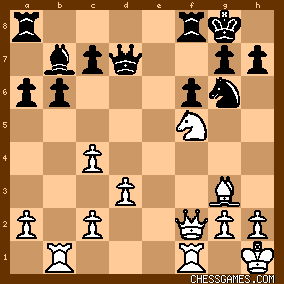
click for larger view20. h4?!
Going for the gold. Tchigorin had numerous other ways of trying to force play (e.g., 20. Qd4, 20. c5, or 20. a4). But, true to form, he went for the jugular with an Alpha-Zero type h-pawn thrust. I wonder if this is what Alpha Zero would play here. (Stockfish and Fritz frown on the text, but I like it). 20... Ne5
20...Rae8 or 20...Rf7 look more accurate.
21. Rbe1
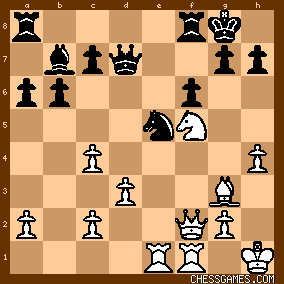
click for larger view21... Rae8?
An uncharacteristically careless move from Schlechter. Tchigorin's forceful play often had this effect on his opponents. Schlechter obviously overlooked Tchigorin's 23rd move. 22. BxN fxB
23. Rxe5!
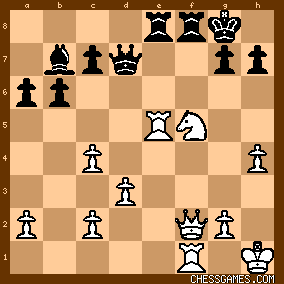
click for larger viewMy guess is that only now did Schlechter notice that 23...RxR?? leads to mate in two beginning with 24. Nh6+!. 23... Rf6
24. RxR+
24. Qe3 or 24. Qe2 were stronger.
24... QxR

click for larger viewIn light of the doubled c-pawn, I doubt this is a theoretical win for White (though I bet Magnus Carlsen or Bobby Fischer would torture Black and perhaps manage a win). In any case, Tchigorin quickly threw away his edge. 25. Kh2?
Hardly the way to play for a win. 25. Qd4 or 25. Qd4 were much stronger. Perhaps Tchigorin was in time trouble (the move 30 time control then being in effect). 25... Qe5+

click for larger view26. Qg3?
Losing a piece (for which he manages to pick up two pawns. As a result of this (time pressure?) mistake, Tchigorin--who was up a pawn with winning chances just two moves ago now faced a marathon struggle against a fine technician to try to salvage a draw. 26... RxM!
Hard to believe Tchigorin missed this.
27. RxR QxR
28. Qxc7
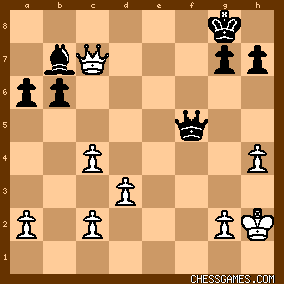
click for larger viewDid Schlechter (with a Bishop for two (and soon to be three) pawns have a win here? It's a close question I will discuss in analyzing the ending. |
|
Nov-05-19
 | | KEG: Post IV
28... Qc8?
This can't be best. Schlechter (who may also have been affected by time pressure with the 30-move control approaching) should have tried 28...Bc8. Play may then have continued 29. Qd8+ Qf8 30. Qxb6 Qf4+ 31. Kg1 Qxh4 with Schlechter having good chances to be one pawn to the good (i.e., having a Bishop for two pawns instead of for three pawns) as compared with what happened in the game. I am far from certain the game would then have been a win for Schlechter; and am also far from sure that the game was a theoretical draw after the text. I am, however, fairly confident that 28...Bc8 would have been better than the text. 29. Qxb6
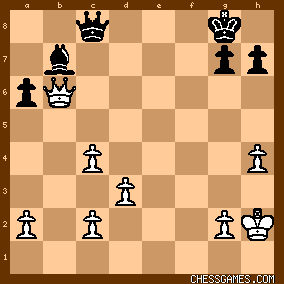
click for larger viewIs this a win for Black? It's a close call, and in what followed Tchigorin had chances to draw and Schlechter seemingly had a few winning chances. It was, even if not perfect, am intriguing struggle in which Tchigorin ultimately managed to hold on. 29... Qc6
29...Qd7 and 29...h6 both look more promising than allowing Tchigorin to trade off Queens (as does the text) 30. Qf2
With one move remaining before the time control, Tchigorin declines to trade down to a six pawn versus Bishop and three pawn ending. This certainly looks like a better way to play for a draw. But Tchigorin may have thought (if indeed he had sufficient time to think about it) that his tactical skill with Queens on the board gave him better practical chances. 30... Qd6+
30...h6 (avoiding any back-rank tactical threats Tchigorin might concoct) or 30...Qe6 seem more accurate. 31. Kg1
Asking for trouble. Tchigorin's desire to keep the Queens on the board notwithstanding, 31. Qg3 was much better. 31... Qe5!
An excellent post for the Queen.
I wonder if Tchigorin now regretted not having traded Queens: 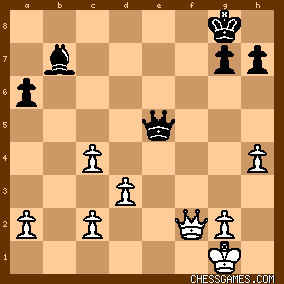
click for larger view32. d4!
Tchigorin's position was now difficult. But he was no potted plant, and decided to use his passed pawns (even though one of them was doubled!) as weapons to harass Schlechter. One thing is for sure, beating Tchigorin in this sort of ending with Queens sweeping the board was no easy task. 32... Qe4
Tcigorin's position was here hanging by a thread. But 32...Qe6 looks even more precise and might have made the Russian's task even more difficult than did the text. 33. Kh2
Maintaining the option to play Kg3 or Kh3 as may be needed to defend the h4 pawn. 33... Bc8
Heading for e6.
34. c3!
Tactics, tactics, tactics. Even what look like simple endings get complex with Tchigorin as the defender. 34... h6
To avoid any coming back-rank threats, and mindful that 34...Be6 immediately would run into 35. d5. 35. a3!
Since Tchigorin is planning to play c5, he had to get his a-pawn off the White square. 35... Kh7
36. c5
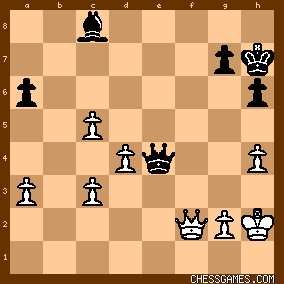
click for larger viewThe plot thickens! |
|
Nov-05-19
 | | KEG: Post V
36... Be6
37. Kg3?!
Creating needless problems for himself. 37. Qg3 or 37. Kg1 were more prudent. 37... Bd5
38. Kh2
Implicitly conceding his prior move was ill-judged. 38... a5?!

click for larger viewSchlechter's usually profound positional sense may have deserted him here. I bet that Tchigorin--had colors been reversed--would have sprung onto the attack with 37...Kg6. 39. Qg3 a4?!
Having ventured down this rabbit hole, Schlechter continued his plan of immobilizing the White Queen-side pawns. But 39...Qe2 was nonetheless better. After 39...a4?! the position was:
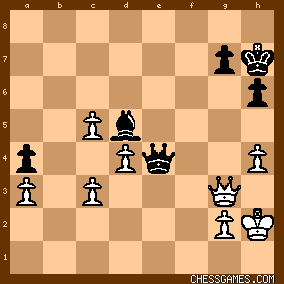
click for larger view40. Kh3?
This should probably have been fatal. Tchigorin, his instincts notwithstanding, had to mark time with 40. Kg1 or 40. Qf2. 40... Qb1?
The wrong way to seek to punish Tchogorin's temerity. 40...Qe2! looks scary for White. The text left the position as follows: 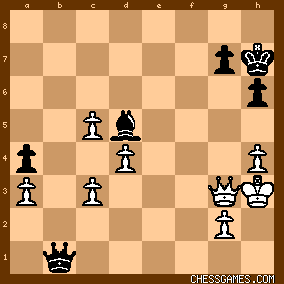
click for larger view41. Qf2?
Still taking needless risks. With 42. Kh2, White would have had excellent drawing prospects in light of the exposed positions of the Black King and Bishop. 41... Qd3+
As will be seen, the threat to the White pawn on c3 is more apparent than real. Schlechter should have played either 41...Qh1+ or 41...Be4, both of which would seem to give him excellent winning chances. 42. Kh2
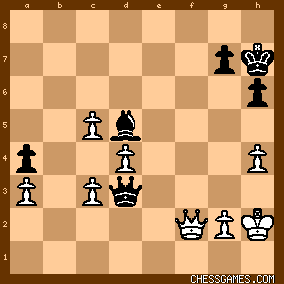
click for larger view42... Kg8?
Oops! The White c3 pawn is immune (42...Qxc3?? 43. Qf5+ and White wins). But 42...Be4 was the way to seek a win. At the very least, Tchigorin's task would have been made far more difficult. 43. Qg3
He now of course needs to defend the c3 pawn more directly. 43... Qf1
43...Qe2 was more promising.
44. Qg4!
Creating new tactical possibilities, beginning with a Queen check now on b8. But sometimes, a threat is greater than its execution, and Tchigorin needed to consider when to spring this resource. After 44. Qg4 the position was:

click for larger view |
|
Nov-05-19
 | | KEG: Post 5A)
Sorry for the typo. What I meant to say, of course, is that Tchigorin now had the option of checking on c8 [not b8] after 55. Qg4. |
|
Nov-06-19
 | | KEG: Post VI
44... Qf2
44...Kh7; 44...Qb1; and 44...Qf8 were all better. 45. Qc8+?
45. h5 or the tricky 45. c6 [45...Bxc6? 46. Qc8+] were better. 45... Kh2
46. Qg4 Qc2
47. h5!

click for larger viewThe c3 pawn is indirectly protected (47...Qxc3?? 48. Qf5+ and White wins] 47... Qd3
47...Be4 was a much better winning chance. But even with the text Black could likely have won with best play. 48. Qf4
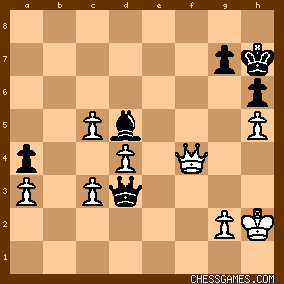
click for larger viewFrom here, and even though the move 45 time control had been reached, Schlechter--instead of pressing for a win with 48...Be4--allowed a draw by triple repetition. Hard to understand unless Schlechter was worn out and decided to call it a day: 48... Qc2
49. Qg4 Qd3
50. Qf4 Qb1
51. Qg4 Qd3
And having repeated the position three times the players agreed to a draw. 1/2 -- 1/2
For whatever reason, this game was not replayed until February 20, twelve days later. Schlechter, playing with colors reversed, won that replay. As a result, Schlechter finished 2nd and Tchigorin wound up tied for 3rd. Had Schlechter won the game at hand here, he would still have finished 2nd, so he lost nothing by allowing Tchigorin to get away with a draw here. |
|
|
|
|





